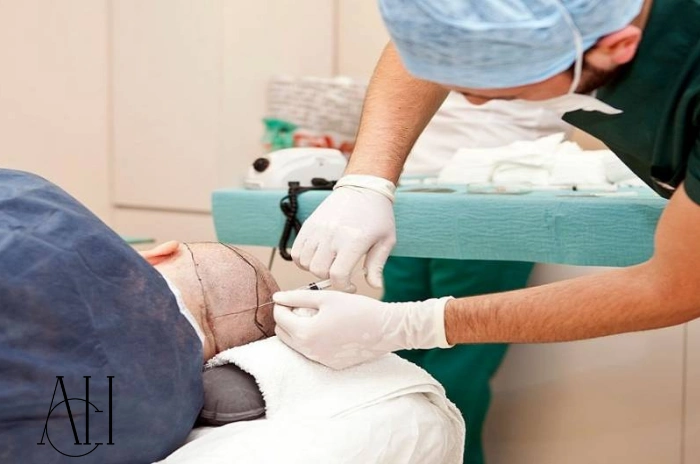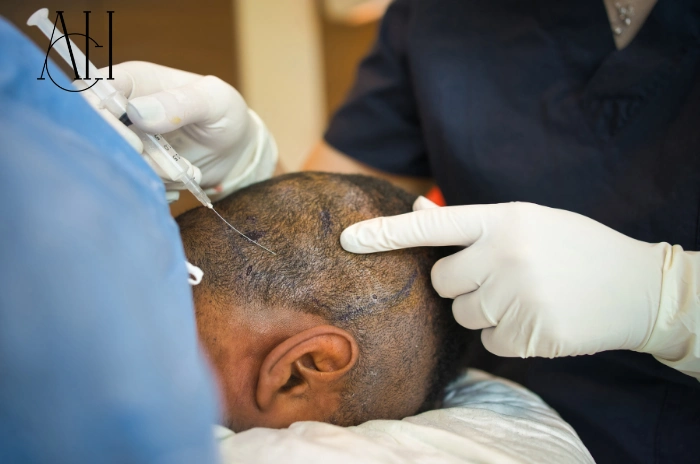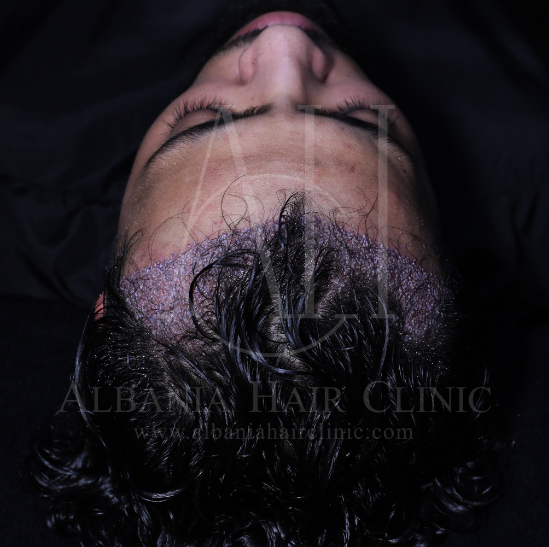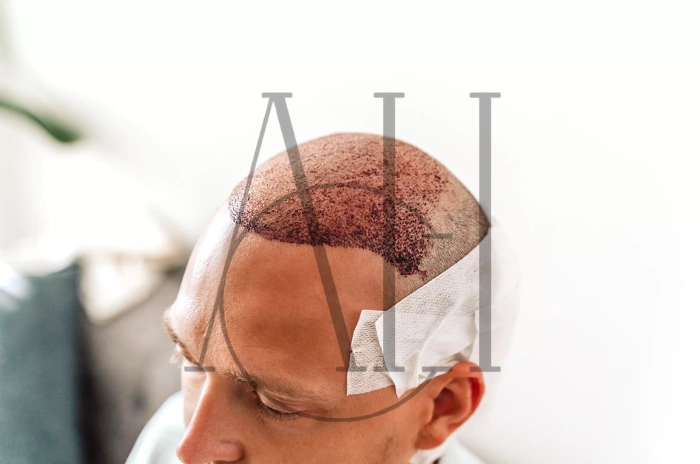Hair transplant surgery has become a popular solution for people suffering from hair loss. One of the most important parts of the procedure is anesthesia. It helps reduce pain, keeps you relaxed, and allows the doctor to work carefully and safely. In this guide, you’ll learn all about the different types of anesthesia used during a hair transplant, how they work, and what to expect before, during, and after the procedure.
Table of Contents
ToggleWhy is Anesthesia Important During Hair Transplant?
Making the Procedure Comfortable
Anesthesia is used to make the hair transplant painless. Without it, the process would be too uncomfortable. It helps the patient stay calm and still, which is important for good results.
Allowing Precise Work
When the patient is comfortable, the doctor can focus on placing the hair grafts carefully. This improves the look and success of the transplant.
What is Local Anesthesia?
A Common Choice
Local anesthesia is the most commonly used type during hair transplant surgeries. It numbs only the area being treated, so the patient stays awake but feels no pain in the scalp.
Fast and Effective
It works quickly and lasts long enough to complete the surgery. The doctor injects it into the skin where the hair will be removed and implanted.
Local Anesthesia with Sedation
Added Comfort
Sometimes, doctors combine local anesthesia with sedation. Sedation helps the patient feel even more relaxed. You stay awake, but feel sleepy and calm.
Better Experience
This option is helpful for people who are nervous about surgery. It can reduce anxiety and make the procedure easier for both patient and doctor.
Pros of Local Anesthesia with Sedation
Less Stress
Patients often feel more at ease with sedation. It lowers fear and makes the surgery feel shorter.
Quick Recovery
Since you are not fully asleep, you recover faster than with general anesthesia. Most people go home the same day.
Albania Hair Clinic – Trapianto Capelli in Albania (@albaniahairclinic)’in paylaştığı bir gönderi
Pros of General Anesthesia
Total Sleep
With general anesthesia, the patient is fully asleep. This may be preferred for people who cannot stay still or are very anxious.
No Memory of Surgery
You will not remember anything about the procedure, which may be a benefit for some people.
Types of Anaesthesia
Main Options
-
Local Anesthesia
-
Local Anesthesia with Sedation
-
General Anesthesia Each type has pros and cons, and the right one depends on your health, comfort, and clinic preference.
Types of General Anaesthesia
Different Techniques
There are several types of general anesthesia, including:
-
Inhaled gases
-
Intravenous (IV) drugs These are used based on patient condition and surgeon preference.
How is Anesthesia Administered before Hair Transplantation?
Step-by-Step
Before the transplant begins, the doctor applies a numbing cream or injects a small needle into the scalp. The area becomes numb in a few minutes.
Comfortable Process
The anesthesia is given slowly and gently. Most people feel only a small pinch or pressure.
Preoperative Local Anesthesia Administration for Hair Transplantation
Planning Ahead
Before the operation, doctors assess your medical history and allergies. This ensures the right type and amount of anesthesia is used.
Skin Test
Sometimes, a test dose is given to make sure there is no allergic reaction.

Methods of Local Anesthesia
Common Techniques
-
Direct injection
-
Nerve blocks
-
Topical cream (before injections) These methods help target specific parts of the scalp with little discomfort.
What to Consider After Local Anesthesia?
Short-Term Effects
You may feel numb for a few hours after surgery. It wears off slowly, and you may feel tingling or sensitivity.
Follow Instructions
Avoid touching or rubbing your scalp until the feeling returns. Follow all care instructions given by your doctor.
Preparing for Anesthesia
Before the Surgery
Your doctor will ask about:
-
Medical conditions
-
Medicines you take
-
Previous reactions to anesthesia It is important to answer honestly to avoid problems.
Food and Drink
Some clinics ask you not to eat or drink a few hours before surgery, especially if sedation or general anesthesia is used.
Risks and Side Effects Of Anesthesia
Possible Reactions
Anesthesia is safe for most people, but side effects can happen:
-
Nausea
-
Dizziness
-
Headache
-
Allergic reaction (rare)
Tell Your Doctor
Inform your doctor if you feel unwell or notice any unusual signs after the surgery.
Benefits of Anaesthesia in Hair Transplant
Pain-Free Procedure
Anesthesia helps you feel no pain during the hair transplant. This makes the whole process more comfortable.
Better Results
With no movement or stress, the surgeon can place the grafts more accurately, which improves your final results.

Facts about Anaesthesia in Hair Transplantation
Safe and Controlled
Modern anesthesia techniques are safe when performed by trained professionals. Complications are very rare.
Patient Comfort First
Anesthesia is always given in a way that keeps the patient safe, relaxed, and stable during the procedure.
Advanced Sedation Technique For Getting A Painless Local Anesthesia
New Methods
Some clinics use advanced tools like vibration devices or cooling sprays. These help reduce the discomfort of the injection.
No Fear Needed
Thanks to new sedation methods, even people who fear needles can feel comfortable during the anesthesia process.
Preparation of the Donor Site
Numbing the Area
Before removing hair from the donor area, the surgeon uses local anesthesia to numb the back or sides of your head.
Keeping You Calm
Sedation can be used here too, especially if many grafts are being removed.
What is involved in hair transplantation – anesthesia for the procedure
Two Areas to Numb
Anesthesia is used in both the donor area (where hair is taken) and the recipient area (where hair is placed). This ensures the whole surgery is painless.
Monitoring During Surgery
The team watches your comfort, heart rate, and other signs throughout the procedure to keep you safe.
Anesthesia during a hair transplant
Whole Process Covered
From start to finish, anesthesia plays a big role in making the experience smooth. The team prepares everything in advance for a safe process.
Tailored for You
Each patient is different. The type and amount of anesthesia is chosen based on your needs.
What is the Role of Anesthesia During a Hair Transplant in Turkey
Comfort in Top Clinics
In Turkey, top hair transplant clinics use advanced anesthesia techniques to offer a painless and stress-free experience for patients.
Focus on Quality
Turkish clinics focus on comfort and safety, offering expert anesthetic care as part of the full treatment package.
How Does Anesthesia Work During a Hair Transplant Procedure?
Blocking Pain Signals
Anesthesia blocks the nerve signals from the scalp to the brain. This stops you from feeling pain even though you are awake.
Long-Lasting Relief
The effects last several hours, enough to complete the surgery without discomfort.
Types of Anesthesia Used During a Hair Transplant in Turkey
Available Options
- Local anesthesia
- Local anesthesia with sedation
- General anesthesia (rare) Most clinics prefer local anesthesia for safety and fast recovery.
Customized for Each Patient
Clinics in Turkey assess your condition to choose the best method for you.
Who Administers Anesthesia During the Hair Transplant in Turkey
Qualified Professionals
Only trained doctors or anesthesia nurses give anesthesia in certified clinics. They monitor your condition and stay nearby throughout the procedure.
Patient Safety First
You are not alone. A professional team watches you closely to make sure everything goes smoothly and safely.
Choosing the right anesthesia is an important step in your hair transplant journey. Whether you’re in Turkey or elsewhere, knowing your options helps you feel more prepared and less nervous. With safe and modern methods like local anesthesia and sedation, the process is almost pain-free. Talk to your clinic, ask questions, and choose the method that makes you feel comfortable and safe.
Frequently Asked Questions
Is anesthesia painful during a hair transplant?
No, anesthesia is used to make the procedure painless. You may feel a slight pinch or pressure during the injection, but the scalp will go numb quickly.
Will I be awake during the hair transplant surgery?
Yes, in most cases. Local anesthesia with or without sedation allows you to stay awake and relaxed, while feeling no pain in the treated area.
Is general anesthesia commonly used for hair transplants?
No, general anesthesia is rare. Most clinics use local anesthesia or local anesthesia with sedation, as they are safer and have quicker recovery times.
How long does the effect of local anesthesia last?
The numbing effect usually lasts for several hours—long enough to complete the entire hair transplant procedure comfortably.
Are there any side effects of hair transplant anesthesia?
Side effects are rare but may include dizziness, mild swelling, or allergic reactions. Your doctor will monitor you and manage any side effects carefully.




